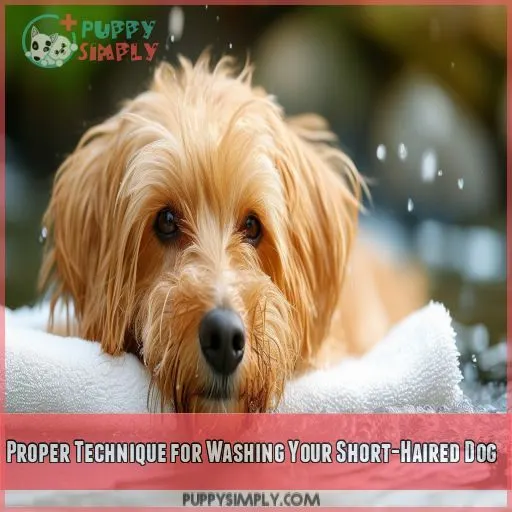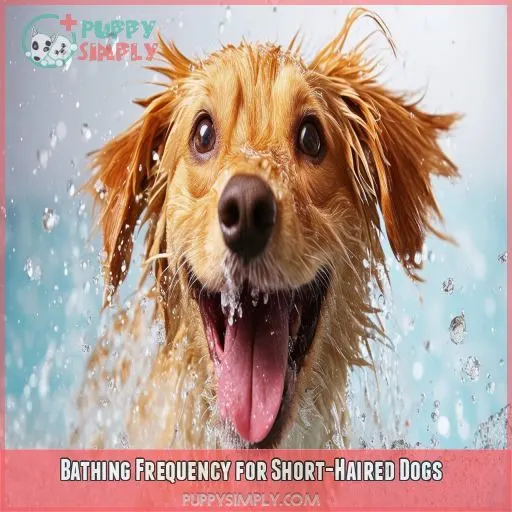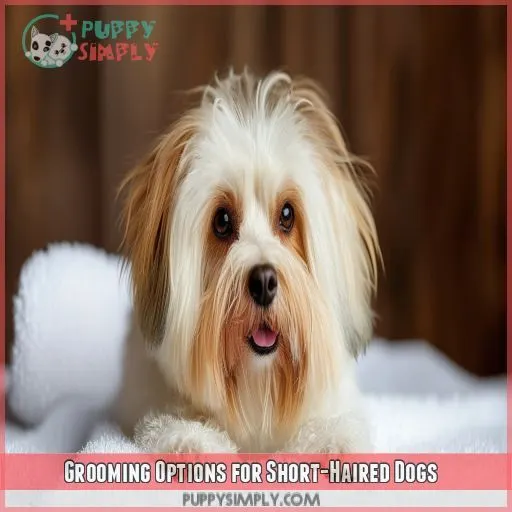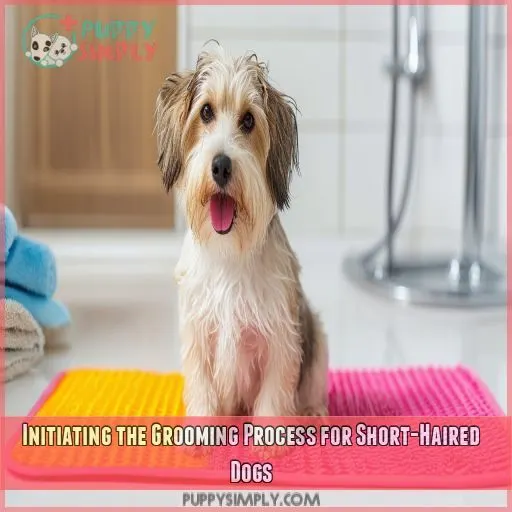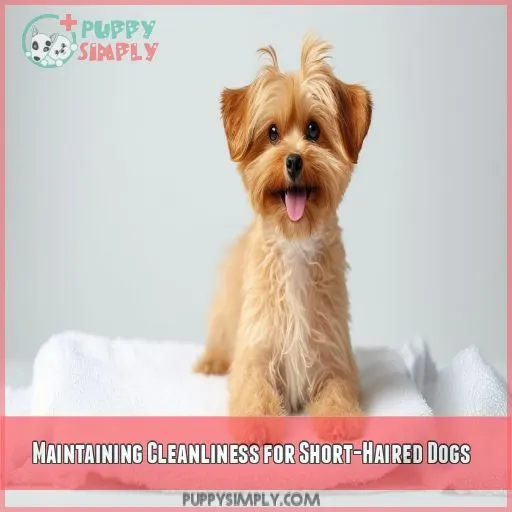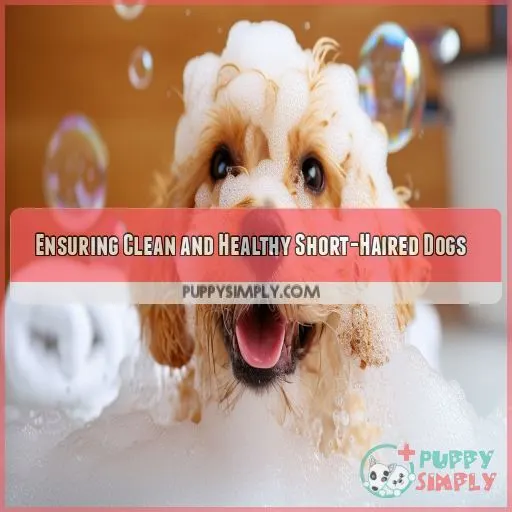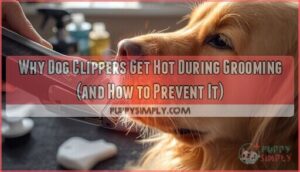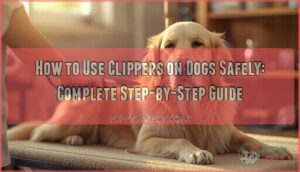This site is supported by our readers. We may earn a commission, at no cost to you, if you purchase through links.
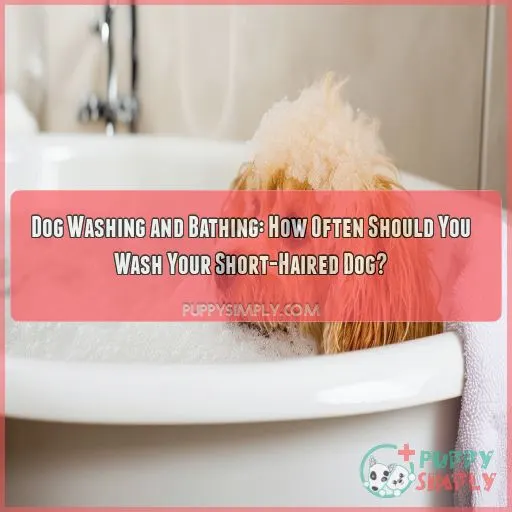
This article will guide you through the process of dog washing and bathing, covering everything from the proper technique to how frequently you should bathe your pup based on factors like age, activity level, and coat type.
Get ready to become a pro at keeping your short-haired dog looking and feeling their best!
Table Of Contents
- Key Takeaways
- Proper Technique for Washing Your Short-Haired Dog
- Bathing Frequency for Short-Haired Dogs
- Grooming Options for Short-Haired Dogs
- Initiating the Grooming Process for Short-Haired Dogs
- Maintaining Cleanliness for Short-Haired Dogs
- Ensuring Clean and Healthy Short-Haired Dogs
- Frequently Asked Questions (FAQs)
- How to properly wash a short-haired dog?
- How often should short-haired dogs be bathed?
- Should I take my short-haired dog to the groomer?
- When grooming a short-haired dog, where do you start?
- What if my dog hates bath time?
- How often should I brush my dogs teeth?
- How do I know if my dog has allergies?
- What shampoo should I use?
- Whats the best way to dry my dog?
- Conclusion
Key Takeaways
- Keep it comfy: Use tepid water and gentle, natural shampoos to avoid irritating your pup’s sensitive skin.
- It’s not a one-size-fits-all: The perfect bathing schedule depends on age, activity level, coat type, and more. Puppies and senior dogs might need less frequent baths.
- Brushing is a big deal: Daily brushing keeps your dog’s coat healthy and shiny, stimulates their skin, and helps prevent tangles and mats.
- Don’t overdo it: Too many baths can strip your dog’s coat of natural oils. Aim for a weekly bath and adjust as needed – it’s all about balance!
Proper Technique for Washing Your Short-Haired Dog
Bath time for your short-haired dog can be a bit of a challenge, but there are a few things to keep in mind.
First, always use tepid water to avoid burning your dog’s sensitive skin.
Next, choose a gentle, vet-approved dog shampoo, avoiding human shampoos, which can be toxic.
Thoroughly wet your dog, then apply a small amount of shampoo, lathering gently.
Be sure to keep the shampoo away from their eyes, ears, nostrils, and mouth.
Rinse well, then towel dry your pup, keeping them warm until their coat is completely dry.
Bathing Frequency for Short-Haired Dogs
How often should you bathe your short-haired dog?
It depends on a few things: their age, how active they are, their coat type, where they live, and even their breed.
All these things play a role in how often your pup needs a bath, so let’s break down each of these factors to find the perfect bathing schedule for your furry friend.
Age Considerations
The age of your dog is an important factor when determining their bathing frequency. Puppies have sensitive skin and require less frequent baths than adult dogs. Senior dogs may also need adjustments to their bathing routine due to potential health issues and skin sensitivity.
Activity Level Impact
Your dog’s activity level impacts the frequency of their baths. Here are some considerations:
- Lifestyle: If your dog is highly active and spends a lot of time outdoors, they may require more frequent bathing to remove dirt and debris.
- Environment: Consider the environment your dog frequents. For example, if they enjoy rolling in the mud, you’ll need to bathe them more often.
- Dog breed: Some breeds are naturally more active than others, so adjust their bathing schedule accordingly.
Coat Type Influence
The coat’s texture, density, and shedding rate influence bathing frequency. Weekly baths are recommended for short-haired dogs, with daily brushing to manage shedding.
Environmental Factors
When deciding how often to wash your short-haired dog, consider these environmental factors:
- Weather and Climate: Depending on the weather and climate, you might need to adjust your dog’s bathing frequency. For example, in hot and humid climates, your dog may need more frequent baths to stay cool and comfortable.
- Seasons: Seasonal changes can also impact your dog’s grooming needs. For instance, during the winter, your dog may require less frequent baths as they spend less time outdoors and their coat may become drier.
- Pollution and Dust: If you live in an area with high pollution or dust levels, your dog may need more frequent baths to remove dirt and debris from their coat.
- Dog Allergies and Skin Sensitivities: Pay attention to any signs of allergies or skin sensitivities in your dog. Certain environmental allergens, such as pollen or grass, may require more frequent bathing to reduce your dog’s exposure.
Breed Variations
When you’re thinking about bathing your short-haired dog, it’s important to think about things like how much they shed, their coat type, size, lifestyle, and how they’re around people. Different dog breeds need different levels of grooming, so it’s important to adjust your dog’s grooming routine to match their needs.
Grooming Options for Short-Haired Dogs
Grooming your short-haired dog involves more than just bathing. Here are some tips to keep your pup’s coat looking its best:
- Brush your dog’s coat regularly with a quality brush to remove loose hair and dirt. Focus on areas prone to matting.
- Trim your dog’s nails weekly to keep them short and comfortable.
- Spot-check your dog’s paw pads and ears regularly for any issues.
- Use gentle, natural shampoos and conditioners to avoid irritating your dog’s sensitive skin.
- Maintain your dog’s dental hygiene by brushing their teeth regularly to prevent dental disease.
Initiating the Grooming Process for Short-Haired Dogs
Grooming your short-haired dog at home is a breeze with the right tools and products. First, see if your dog needs a bath. If they’re looking or smelling a little rough, it’s probably time for a wash. Use a gentle dog shampoo and apply a dog-friendly conditioner to keep their coat soft and healthy. Let your dog air-dry or use a low-heat setting on a dog dryer.
Nail care is also important. Keep your dog’s nails short and trim any excess hair around their paws. This will keep them looking neat and tidy but will also help maintain their overall health and comfort.
Maintaining Cleanliness for Short-Haired Dogs
Maintaining your short-haired dog’s cleanliness is more than just regular baths. It’s about brushing them daily, using the right shampoo, and not overdoing it with baths.
Regular Brushing Practices
Regular brushing is a key component of maintaining your short-haired dog’s cleanliness and overall health. Brushing stimulates your dog’s skin, improving circulation and distributing natural oils for a healthy coat. It also helps remove loose hair, dirt, and debris, reducing the occurrence of matting and keeping your dog’s coat looking neat and tidy.
The frequency of brushing depends on your dog’s coat and lifestyle. As a general rule, aim for daily brushing, particularly if your dog spends a lot of time outdoors or has a high activity level. This helps prevent tangles and keeps their coat in good condition.
When it comes to tools, invest in a quality brush specifically designed for dogs. A stiff bristle brush with tightly packed bristles is ideal for removing dead hair and distributing natural oils. Use it on dry hair for best results. You can also use a dog bath brush to enhance the effectiveness of brushing during bath time.
Selection of Suitable Shampoo
When selecting a shampoo for your short-haired dog, it’s important to prioritize their skin sensitivity and choose gentle, natural formulas. Opt for pH-balanced and hypoallergenic options to avoid any potential irritation. Consult the dog’s owner and veterinarian if there are any known allergies to grooming products.
Moderation in Bathing Frequency
Finding the right balance in bathing your short-haired dog is important.
Too much can strip their coat of natural oils, causing dryness and irritation.
Conversely, too little bathing can lead to a buildup of dirt, oils, and bacteria, resulting in skin issues and an unpleasant odour.
Aim for a weekly bath, adjusting as needed based on your dog’s lifestyle and skin condition.
Ensuring Clean and Healthy Short-Haired Dogs
Ensuring your short-haired dog maintains a healthy coat and overall well-being involves a combination of regular grooming, thoughtful product selection, and a mindful approach to bath time. Here are some additional tips to keep your canine companion in tip-top shape:
- Invest in quality grooming tools, including a good brush and nail clippers.
- Opt for gentle, natural shampoos and conditioners that are easy to rinse and suitable for sensitive skin.
- Keep your dog’s nails trimmed short to prevent discomfort and potential health issues like arthritis.
- Don’t forget dental hygiene! Brush your dog’s teeth regularly to prevent dental disease and maintain their overall health.
- Spot-check your dog’s paw pads and ears regularly for any signs of dryness, irritation, or infection.
Frequently Asked Questions (FAQs)
How to properly wash a short-haired dog?
Use tepid water and a vet-approved shampoo. Wet your dog, avoiding their face. Lather, scrub, and rinse thoroughly. Clean their face with a washcloth. Towel dry, brush, and air dry.
How often should short-haired dogs be bathed?
Short-haired dogs should be bathed every six to eight weeks. However, this may vary depending on your dog’s coat type, activity level, and health.
Should I take my short-haired dog to the groomer?
Yes, short-haired dogs need grooming too. Groomers have the right tools, like a stiff bristle brush, to help keep your dog’s coat healthy. They’ll also inspect your dog’s paw pads, ears, and skin for any issues.
When grooming a short-haired dog, where do you start?
Start with a pre-bath brush to remove loose hair. Then, soak, lather, and scrub, taking care around sensitive areas. Rinse and dry, finishing with a post-bath brush.
What if my dog hates bath time?
Dogs may hate bath time due to the loss of control and unfamiliarity of the experience. Bad associations with past bathing experiences can also cause fear. To improve bath time, create a comfortable environment, use the right products, and consider professional help.
How often should I brush my dogs teeth?
Brushing your dog’s teeth is like tending to a garden. Just as you’d water plants daily, aim to brush your dog’s teeth daily, or at least 3-5 times a week. This will prevent plaque and tartar buildup, saving you money and your dog discomfort.
How do I know if my dog has allergies?
Common symptoms of allergies in dogs include itching, licking, hair loss, and rashes. You may also notice red skin or fur loss on their paws, lower legs, face, ears, armpits, and belly.
What shampoo should I use?
Choose a vet-approved, gentle, and natural shampoo for your dog’s sensitive skin. Avoid human shampoos as they can be toxic. Look for ingredients like coconut oil, aloe, and shea butter.
Whats the best way to dry my dog?
When drying your dog, it’s best to use absorbent towels, like microfiber towels, to carefully squeeze water out of their hair. Start with their head, then move backward to their tail, and work from their backside down to their belly, legs, and paws. If using a dryer, remember that it’s the airflow, not the heat, that dries their coat.
Conclusion
Keeping your short-haired dog clean can feel like a puzzle: it’s tricky, but with the right tools, you’ll find the solution.
This guide has provided a roadmap for mastering the art of dog washing and bathing, ensuring your pup stays fresh and healthy.
From technique to timing, age to activity, and coat type to cleanliness, you’re now equipped with the knowledge to handle dog grooming like a pro.

